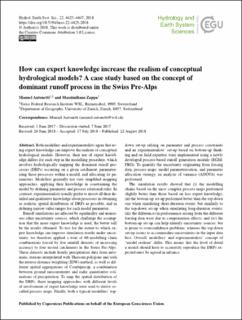Please use this identifier to cite or link to this item:
https://doi.org/10.21256/zhaw-4749| Publication type: | Article in scientific journal |
| Type of review: | Peer review (publication) |
| Title: | How can expert knowledge increase the realism of conceptual hydrological models? : a case study based on the concept of dominant runoff process in the Swiss Pre-Alps |
| Authors: | Antonetti, Manuel Zappa, Massimiliano |
| DOI: | 10.21256/zhaw-4749 10.5194/hess-22-4425-2018 |
| Published in: | Hydrology and Earth System Sciences |
| Volume(Issue): | 22 |
| Issue: | 8 |
| Page(s): | 4425 |
| Pages to: | 4447 |
| Issue Date: | 22-Aug-2018 |
| Publisher / Ed. Institution: | Copernicus |
| ISSN: | 1607-7938 1027-5606 |
| Language: | English |
| Subjects: | Dominant runoff process; Expert knowledge |
| Subject (DDC): | 551: Geology and hydrology |
| Abstract: | Both modellers and experimentalists agree that using expert knowledge can improve the realism of conceptual hydrological models. However, their use of expert knowledge differs for each step in the modelling procedure, which involves hydrologically mapping the dominant runoff processes (DRPs) occurring on a given catchment, parameterising these processes within a model, and allocating its parameters. Modellers generally use very simplified mapping approaches, applying their knowledge in constraining the model by defining parameter and process relational rules. In contrast, experimentalists usually prefer to invest all their detailed and qualitative knowledge about processes in obtaining as realistic spatial distribution of DRPs as possible, and in defining narrow value ranges for each model parameter. Runoff simulations are affected by equifinality and numerous other uncertainty sources, which challenge the assumption that the more expert knowledge is used, the better will be the results obtained. To test for the extent to which expert knowledge can improve simulation results under uncertainty, we therefore applied a total of 60 modelling chain combinations forced by five rainfall datasets of increasing accuracy to four nested catchments in the Swiss Pre-Alps. These datasets include hourly precipitation data from automatic stations interpolated with Thiessen polygons and with the inverse distance weighting (IDW) method, as well as different spatial aggregations of Combiprecip, a combination between ground measurements and radar quantitative estimations of precipitation. To map the spatial distribution of the DRPs, three mapping approaches with different levels of involvement of expert knowledge were used to derive so-called process maps. Finally, both a typical modellers' top-down set-up relying on parameter and process constraints and an experimentalists' set-up based on bottom-up thinking and on field expertise were implemented using a newly developed process-based runoff generation module (RGM-PRO). To quantify the uncertainty originating from forcing data, process maps, model parameterisation, and parameter allocation strategy, an analysis of variance (ANOVA) was performed. The simulation results showed that (i) the modelling chains based on the most complex process maps performed slightly better than those based on less expert knowledge; (ii) the bottom-up set-up performed better than the top-down one when simulating short-duration events, but similarly to the top-down set-up when simulating long-duration events; (iii) the differences in performance arising from the different forcing data were due to compensation effects; and (iv) the bottom-up set-up can help identify uncertainty sources, but is prone to overconfidence problems, whereas the top-down set-up seems to accommodate uncertainties in the input data best. Overall, modellers' and experimentalists' concept of model realism differ. This means that the level of detail a model should have to accurately reproduce the DRPs expected must be agreed in advance. |
| URI: | https://digitalcollection.zhaw.ch/handle/11475/12143 |
| Fulltext version: | Published version |
| License (according to publishing contract): | CC BY 3.0: Attribution 3.0 Unported |
| Departement: | Life Sciences and Facility Management |
| Organisational Unit: | Institute of Natural Resource Sciences (IUNR) |
| Appears in collections: | Publikationen Life Sciences und Facility Management |
Files in This Item:
| File | Description | Size | Format | |
|---|---|---|---|---|
| antonetti_expert-knowledge_hess-22-4425-2018.pdf | 7.56 MB | Adobe PDF |  View/Open |
Show full item record
Antonetti, M., & Zappa, M. (2018). How can expert knowledge increase the realism of conceptual hydrological models? : a case study based on the concept of dominant runoff process in the Swiss Pre-Alps. Hydrology and Earth System Sciences, 22(8), 4425–4447. https://doi.org/10.21256/zhaw-4749
Antonetti, M. and Zappa, M. (2018) ‘How can expert knowledge increase the realism of conceptual hydrological models? : a case study based on the concept of dominant runoff process in the Swiss Pre-Alps’, Hydrology and Earth System Sciences, 22(8), pp. 4425–4447. Available at: https://doi.org/10.21256/zhaw-4749.
M. Antonetti and M. Zappa, “How can expert knowledge increase the realism of conceptual hydrological models? : a case study based on the concept of dominant runoff process in the Swiss Pre-Alps,” Hydrology and Earth System Sciences, vol. 22, no. 8, pp. 4425–4447, Aug. 2018, doi: 10.21256/zhaw-4749.
ANTONETTI, Manuel und Massimiliano ZAPPA, 2018. How can expert knowledge increase the realism of conceptual hydrological models? : a case study based on the concept of dominant runoff process in the Swiss Pre-Alps. Hydrology and Earth System Sciences. 22 August 2018. Bd. 22, Nr. 8, S. 4425–4447. DOI 10.21256/zhaw-4749
Antonetti, Manuel, and Massimiliano Zappa. 2018. “How Can Expert Knowledge Increase the Realism of Conceptual Hydrological Models? : A Case Study Based on the Concept of Dominant Runoff Process in the Swiss Pre-Alps.” Hydrology and Earth System Sciences 22 (8): 4425–47. https://doi.org/10.21256/zhaw-4749.
Antonetti, Manuel, and Massimiliano Zappa. “How Can Expert Knowledge Increase the Realism of Conceptual Hydrological Models? : A Case Study Based on the Concept of Dominant Runoff Process in the Swiss Pre-Alps.” Hydrology and Earth System Sciences, vol. 22, no. 8, Aug. 2018, pp. 4425–47, https://doi.org/10.21256/zhaw-4749.
Items in DSpace are protected by copyright, with all rights reserved, unless otherwise indicated.